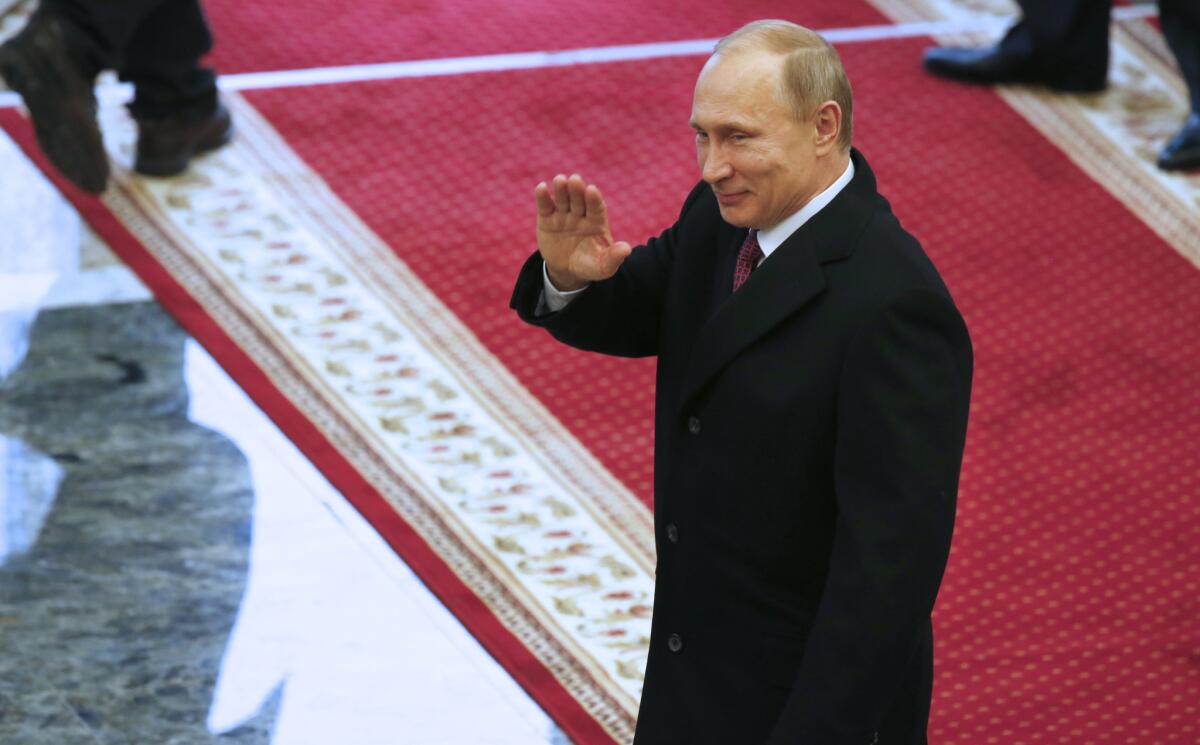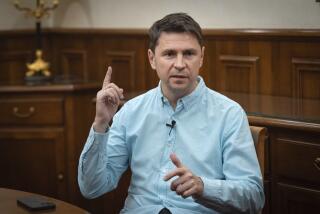Leaders reach new Ukraine cease-fire accord, but doubt remains

Reporting from Moscow — European leaders hoping to avert the infusion of U.S. weapons into the Ukraine conflict heralded a new cease-fire agreement Thursday after marathon negotiations with the Russian and Ukrainian presidents.
But the peace plan’s success hinges on the combatants delivering on promises they’ve made and broken before.
The deal crafted by the leaders of Germany, France, Russia and Ukraine calls for a halt to hostilities by Sunday and withdrawal of heavy weapons, foreign fighters and their armaments from the battlefields within two weeks.
It also requires restoration of Ukrainian government control over its eastern border by the end of this year, contingent on Kiev granting more autonomy to the restive regions.
There were gains and losses for both sides, but also enough vagueness in some provisions to induce broad skepticism that the peace plan will work.
For example, Russian President Vladimir Putin and his Ukrainian counterpart, Petro Poroshenko, immediately gave conflicting accounts of how the fierce battle now raging over a strategic railway junction in the town of Debaltseve is to be resolved.
Two elements of the 13-point peace plan brokered by German Chancellor Angela Merkel and French President Francois Hollande appeared to pose particularly worrisome pitfalls.
One is the vast no man’s land that will be left between the Russia-backed separatists and the Ukrainian government forces if they comply with the withdrawal provisions. As wide as 87 miles in places, it could offer an alluring incentive for either side to move in.
The other major stumbling block is likely to be the long lead time — more than 10 months — before the separatists have to surrender control of eastern Ukraine’s border with Russia to Kiev authorities. The rebel-occupied Donetsk and Luhansk regions have depended on reinforcements from Russia throughout the conflict, and the looming threat of losing that lifeline creates another disincentive for the separatists to abide by the agreement.
The separatists reportedly signed off on the details of the agreement, and Putin pledged to use his influence to see that they are enforced. In return, the Ukrainian government is obligated to resume paying pensions and salaries to residents of the occupied areas, a move that should bolster the rebels’ standing with their battered constituents.
Nearly a million people have fled eastern Ukraine since fighting erupted 10 months ago, and those left behind have suffered through the winter with water, heating and electricity interruptions, food and medicine shortages and near-daily artillery barrages.
One key setback for the separatist leaders was that the accord calls for elections for regional government offices under Ukrainian law. That demonstrates the international community’s rejection of the legitimacy of the rebels’ self-proclaimed independent republics, as well as the November vote that produced their current leaders.
Russia’s official Tass news agency said the peace plan sets out a one-month deadline for organizing a new vote, an ambitious prospect for the regions that have been cut off from central rule since April.
Even more daunting for the Ukrainian leadership will be the accord’s requirement for constitutional changes to decentralize power from Kiev and give more latitude to the diverse regions to set trade and security policy. Ukrainian lawmakers have said they won’t even discuss decentralization unless all occupied territory is returned to Kiev’s control — and Thursday’s accord makes no mention of Russia’s annexation of Crimea 11 months ago.
The degree to which Ukraine must devolve power to the regions was unclear, leaving Putin and Poroshenko to both claim victory in their assessments of the truce and its consequences.
“The expanding of powers for Ukraine’s regions will proceed within the framework of constitutional changes aimed at decentralization,” Poroshenko said in a statement. “We haven’t accepted a single compromise aimed at federalization.”
Putin sought the “federalization” of Ukraine, which would give even greater authority to the regions, because it would in effect give him veto power through his separatist proxies over important decisions by the Kiev government. The Russian president has been especially determined to stop Ukraine from pursuing membership in the European Union and the North Atlantic Treaty Organization.
It was western Ukrainians’ toppling of Kremlin-allied President Viktor Yanukovich a year ago that handed power to pro-Europe politicians who have antagonized Putin by setting a course for reorienting Ukraine’s relations away from Russia and to the West.
Vadim Karasyov, director of the Institute of Global Strategies in Kiev, said the accord gave more to the Ukrainian side by rejecting Moscow’s attempts to force restructuring of Ukraine in a way that would allow Russia to bridle Kiev’s authority over Ukrainian national affairs.
“Putin, faced with a new round of sanctions and the U.S. possible decision to supply Ukraine with weapons, was desperate to arrive at some compromise at any price,” Karasyov said. “Poroshenko needed to stop the war, even temporarily, but not at any price.”
Ukraine’s U.S. and European allies welcomed the cease-fire but expressed doubt about its ability to end the conflict. Even its brokers were cautious in their predictions.
“We now have a glimmer of hope,” Merkel told reporters after spending 16 hours wrangling with Putin and Poroshenko. “But the concrete steps, of course, have to be taken. And we will still face major obstacles. But, on balance, I can say what we have achieved gives significantly more hope than if we had achieved nothing.”
Putin announced the agreement in a televised statement after the all-nighter in Minsk, Belarus’ capital. He hailed the plan’s promise of greater autonomy for separatist regions and deemed what he suggested was de facto recognition of the rebels’ recent advances “of extreme importance.”
The deal was negotiated under the pressure of an emerging campaign among U.S. foreign policy officials to send arms to the Ukrainian government to help its troops put down the insurgency by Russia-backed separatists. The conflict has claimed more than 5,350 lives, the United Nations said this month.
The Obama administration welcomed the agreement as “a potentially significant step toward a peaceful resolution of the conflict,” but alluded to fighting in eastern Ukraine as the talks proceeded as “inconsistent with the spirit of the accord.”
Artillery exchanges continued in eastern Ukraine on Thursday, with two Ukrainian soldiers killed and 21 wounded in the previous 24 hours, the National Security and Defense Council in Kiev reported. Council spokesman Andriy Lysenko also told reporters that Russia sent an additional 50 tanks and a dozen heavy guns into rebel-held territory overnight as the peace talks were underway.
“Actions will be what matter now,” U.S. Secretary of State John F. Kerry said after the cease-fire was announced. “The first test of this agreement and the prospects for a comprehensive settlement will be the full implementation of the cease-fire and the withdrawal of heavy weapons by all parties — by Ukraine, the separatists and Russia.”
Loiko reported from Moscow and Williams from Los Angeles. Special correspondent Victoria Butenko contributed to this report from Kiev.
More to Read
Sign up for Essential California
The most important California stories and recommendations in your inbox every morning.
You may occasionally receive promotional content from the Los Angeles Times.











